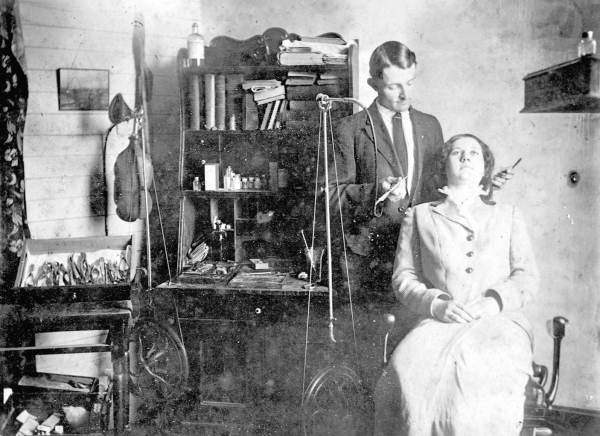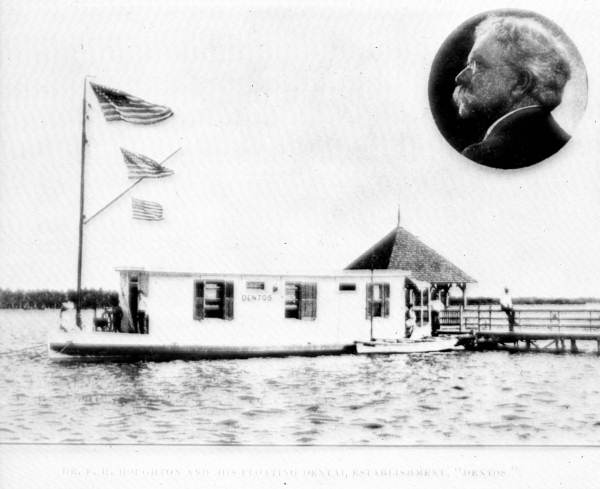Description of previous item
Description of next item
Early Dentistry in Florida
Published August 8, 2014 by Florida Memory
OUCH!!! Going to the dentist doesn’t generally fall on many people’s list of favorite things to do, but like it or not it’s a crucial part of maintaining oral health. Moreover, dentists in the twenty-first century have technology available that makes oral care much, much more comfortable and safe than it was in earlier days. Today we take a broad sweeping look at the dental profession in Florida from territorial days to the modern era.
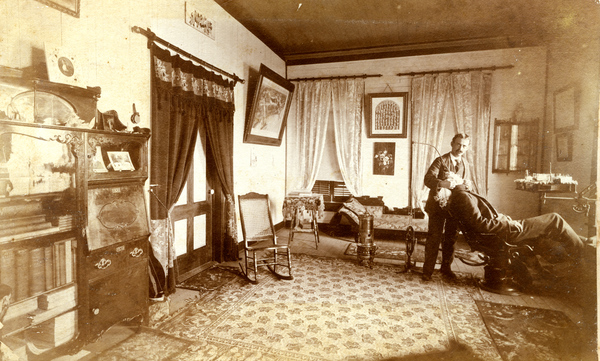
Dentist Charles N. Clark with a patient at his office at 93 Market Street in Apalachicola (February 1899).
Probably the most profound difference between dentistry today and the profession in the early nineteenth century is that prior to about 1840 dentists were not really considered professionals or doctors. They were tradesmen, much like barbers, midwives, or blacksmiths. Their education came not from a university or dental school, but from apprenticeships with older, experienced dentists.
Perhaps the lack of formal dental school training came from there also being a lack of standardized equipment or technique for the young dentist to learn. Before dentistry became organized as a profession, each dentist made his own drugs, if indeed he used them at all. He made his own equipment, or used whatever was available. Replacement teeth came from animals or from the deceased. Antiseptics or anesthesia? With the slight exception of whiskey, forget about it.
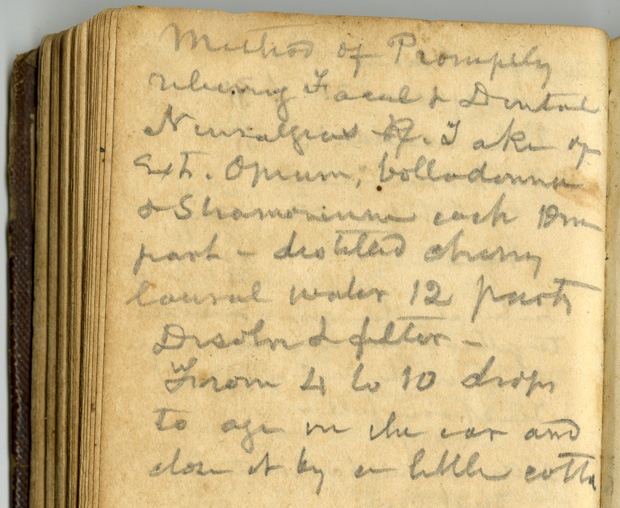
Page from the journal of physician Dr. John M.W. Davidson of Gadsden County, giving a recipe for a treatment for “facial and dental neuralgias,” essentially toothaches. Davidson began keeping the journal in 1843. Click on the image for a full transcription.
As was the case with many professions during the nineteenth century, dentists began communicating with one another, establishing best practices, and sharing their techniques with one another. The founding of the world’s first dental school in Baltimore, Maryland in 1840 was followed by more openings around the country, and dentists soon were able to distinguish themselves with degrees marking them as formally trained professionals.
Some of the first professional dentists in Florida included Dr. Andrew Brookins of Jacksonville, Dr. Edward Dinus Neve of Tampa, Dr. James Chace of Cedar Key, Dr. William H. Bracey of Gainesville, and Dr. J.M. Baggett of Dunedin.
In 1883, Dr. James Chace of Cedar Key met with other dentists from around the state and laid plans for a professional society of dentistry that would help create and maintain standards for ethical practices. The Florida State Dental Society was founded the next year with twenty-five charter members, and they immediately set to work urging the state government to pass laws regulating the practice of dentistry in Florida.
The Society was successful; in 1887 the state legislature passed an act creating a Board of Dental Examiners and making it illegal to practice dentistry without a certificate of the board’s endorsement. Practicing without a license became a misdemeanor punishable by fine, although curiously the law stipulated that teeth could still be extracted by anyone regardless of whether they had received any sort of dental training.
The application process for a certificate was fairly simple, even into the early twentieth century. Applicants were questioned about their attendance at dental school, whether they had practiced dentistry elsewhere, whether they had been convicted or indicted in any felony cases, whether they were addicted to “the liquor or drug habit,” and whether they had ever been prosecuted for illegally practicing dentistry. If the answers to these questions appeared to be in good order, the Board of Examiners would subject the applicant to an exam, part written and part clinical. If the applicant passed both portions, he would be issued a certificate.
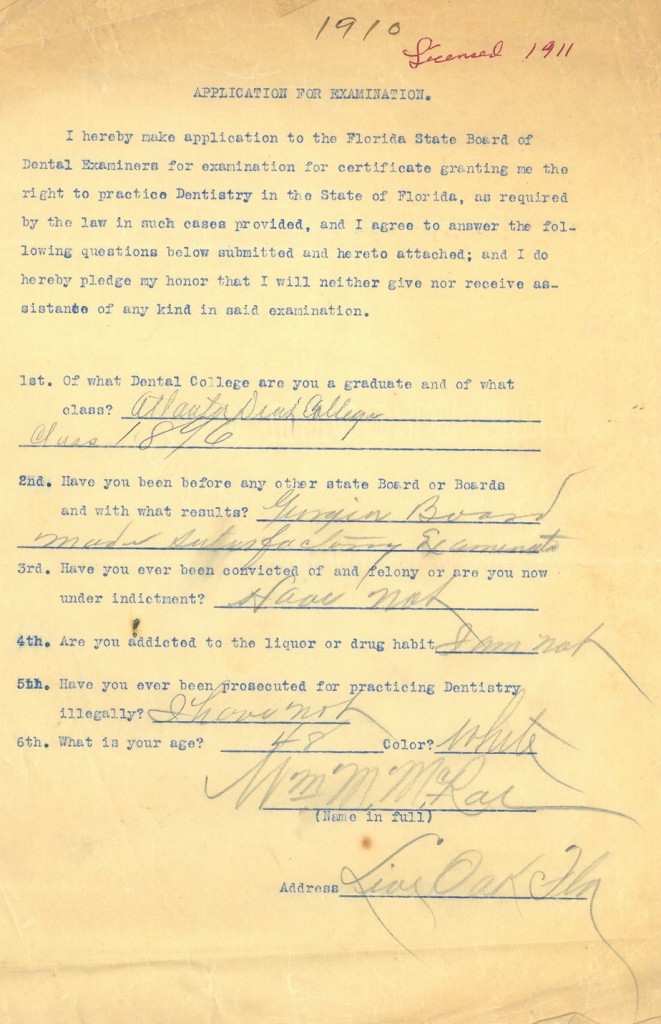
An example of an application for examination by the State Board of Dental Examiners. This application was made by William M. McRae of Live Oak in 1910 (Box 4, Series 394, State Archives of Florida).
At the turn of the twentieth century, even with improvements in technique, tools, and dental education, practicing dentistry required a bit of innovation and willingness to think outside the box. Many dentists had offices in town, much like we usually see today. Transportation, however, was often problematic and inconvenient for many Florida residents living on farms and settlements far away from the larger towns, and so many dentists often took to the roads in wagons, automobiles, and even boats to reach their patients. In the following quote, Dr. Alton B. Whitman of Orlando describes his method for treating “remote” patients around the turn of the century.
“The patient sat in a high-back rocking chair which was padded with pillows and quilts and propped into position with pieces of stovewood under the rockers. The work was usually done on the porch for good light. Sometimes, for extracting [teeth], two straight chairs were placed back to back. The operator’s left foot was put on the seat of the chair back of the patient, and his knee became the headrest, which afforded very good control.”
Dr. F.H. Houghton of Palm Beach developed his own method for getting to the patients who needed him most. In 1898, when he began his practice, the population of Palm Beach was too small to support Houghton’s business, but the residents along the Halifax, Indian, and Hillsborough rivers still needed plenty of dental work. The good doctor solved the puzzle by building a boat 153 feet long and 20 feet wide, on which he constructed several rooms outfitted with all the necessary equipment for practicing modern dentistry. Houghton aptly named his floating office the “Dentos.”
Over time, dentistry standards became more intricate and rigorous, and dentists’ offices began looking more like they do today. The early history of Florida dentistry is, however, a reminder of how dedicated practitioners of the profession were to doing the best they could with what they had.
What was going to the dentist like when you were young? Do you remember dental practices from that time period that are no longer in use? Tell us about it when you share this article on Facebook.
Cite This Article
Chicago Manual of Style
(17th Edition)Florida Memory. "Early Dentistry in Florida." Floridiana, 2014. https://www.floridamemory.com/items/show/295200.
MLA
(9th Edition)Florida Memory. "Early Dentistry in Florida." Floridiana, 2014, https://www.floridamemory.com/items/show/295200. Accessed January 5, 2026.
APA
(7th Edition)Florida Memory. (2014, August 8). Early Dentistry in Florida. Floridiana. Retrieved from https://www.floridamemory.com/items/show/295200

 Listen: The Folk Program
Listen: The Folk Program